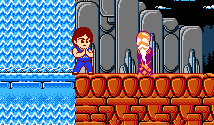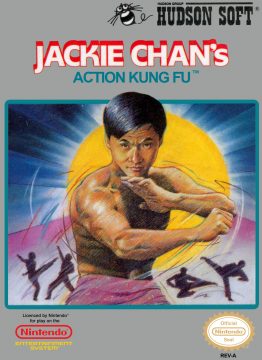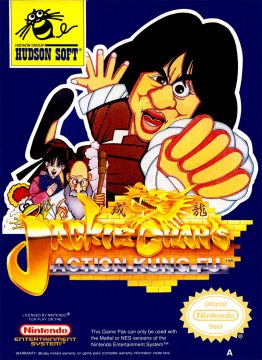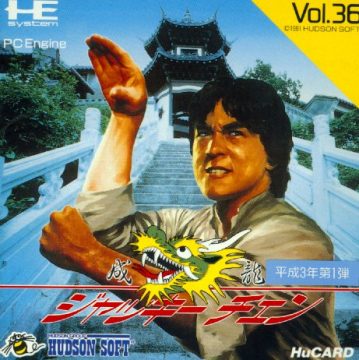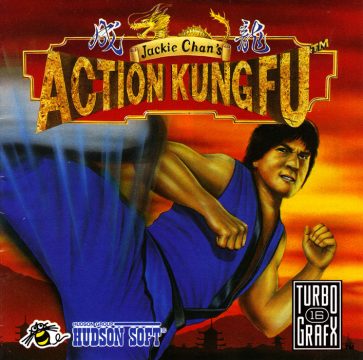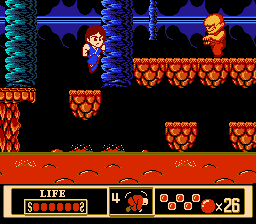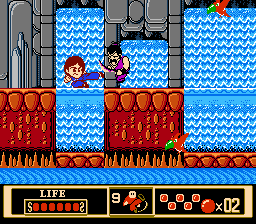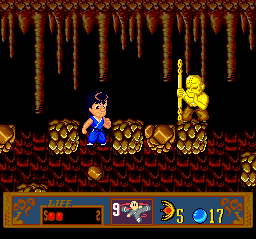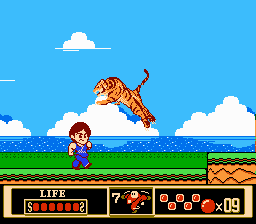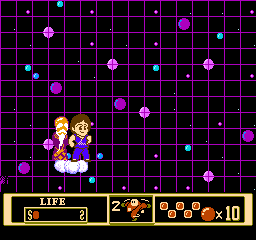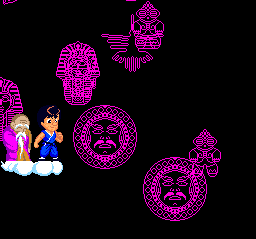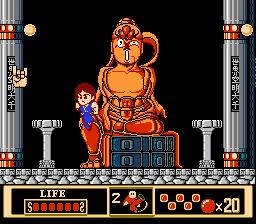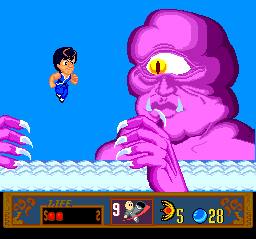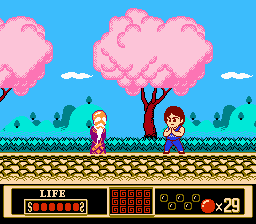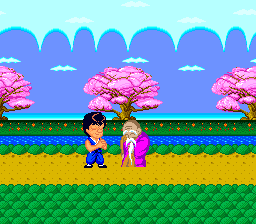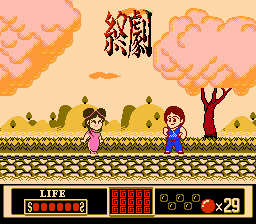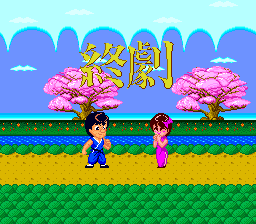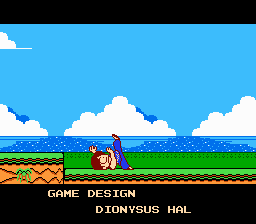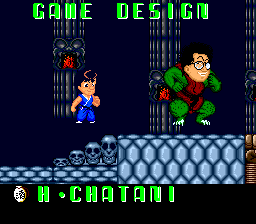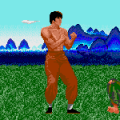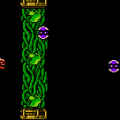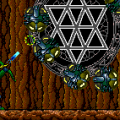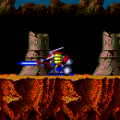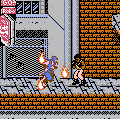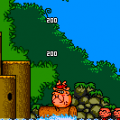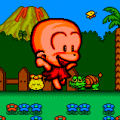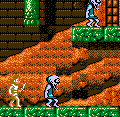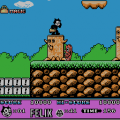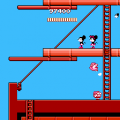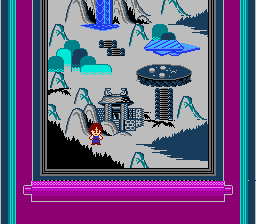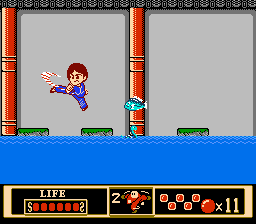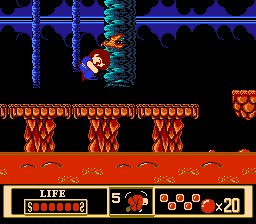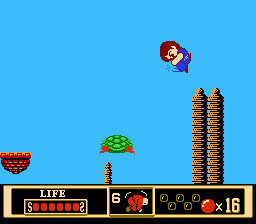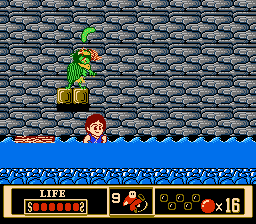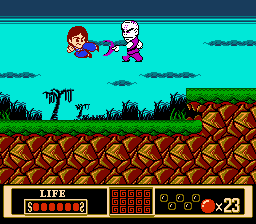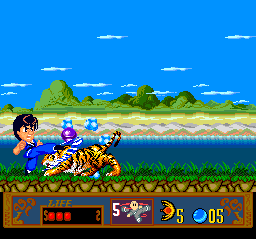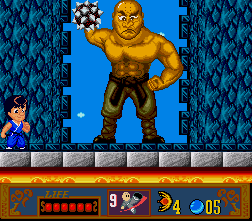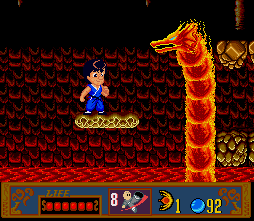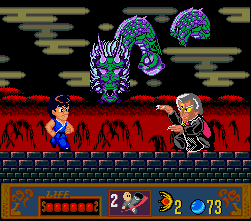By the end of the ’80s, there was one undisputed king in the world of video games, and that was Nintendo. With the Famicom they had taken the world by storm, and it seems only natural that Asia’s biggest superstar and Japan’s favorite good guy would eventually land his own title on the console. In 1990, Hudson Soft picked up the licence to his likeness, and they set out to create a Jackie Chan worthy game on the system. Unlike all the other games, this was not based on any particular movie, but took inspiration from different ones.
In the game you control Jackie, as he sets out to save his twin sister Josephine from the Prince of Sorcerers who kidnaps her at the beginning of the game. As you begin, you get the blessing of the abbott and run into the danger. The graphics are highly stylized, with a distinct anime look and distinct Jackie features, like his bangy hair and comical stances and facial expressions. His sprite is vaguely based on his appearance as Wong Fei Hung in Drunken Master. In the game you have a wide arrange of attacks. You got the standard punch and kicks, you can charge fireballs and shoot long distance, and you can pick up special moves by punching frogs which spit out orbs containing a special move, mostly variations of spin kicks. The enemies include Project A-looking pirates, flying nunchucks, wild tigers, angry birds and pitchfork-wielding maniacs.
There are 5 stages, and as you begin the game a Chinese scroll rolls open and shows you the map and location. The game takes you through the new territories of Hong Kong, from the waterfalls fighting tigers, to the skies on rocket turtle shells and to the fortress to fight evil. The fortress is especially interesting, as it draws more inspiration from Japanese anime with its technology-based design. You’ll find elevators, conveyor belts and electro fields. It’s a bit of stretch that there would be a castle like this in China during the Qing dynasty, but it does add a unique and playful nature to the overall setting of the game.
Graphically it’s one of the nicest looking games in the NES library, with tons of style, fluid animation, big detailed sprites and colorful vibrant backgrounds. The chibi style art lends itself well to the comedy of Jackie, and the game feels very rich and thorough. The controls are quite responsive and it never feels delayed or awkward, and the lightness of Jackie can feel reminiscent of Adventure Island. At times, however, it does suffer from some severe sprite flickering, especially on the last boss, and at times the bosses are virtually invisible for exteneded periods of time due to this, leading to some frustrating battles.
The special moves as mentioned earlier are picked up by hitting the frogs that you will find jumping around on different parts of the levels. When you hit them, a small orb will fly out of their mouths and will disappear after a short period of time if you miss it. The orbs have different symbols which indicate what move you will obtain. These include the Tornado Attack, both 180 and 360 degree Spin Kicks, and a Sky Attack, as well as extra lives and health items.
The music was composed by Masakatsu Maekawa, who was also responsible for the music in Adventure Island 2, 3 and Final Soldier. The score remains strong all the way through the game, with the trademark Hudson Soft catchiness to the melodies and has an especially awesome credits theme.
Hudson later released this title in a slightly updated form on the TurboGrafx-16 / PC Engine in 1991. This version of the game features quite different graphics, opting for a more realistic caricature of Jackie and more faded colors. The stage layout and item distribution has also been changed. This version is also significantly harder than the NES, as some enemies take more hits and have much more reach, and they added a few more bosses to the stages. The music remains mostly the same, though higher quality thanks to the more advanced sound of the system. Jackie also has a voice in this game and cries out as he attacks.
The levels run for much longer on this version, and almost all of the levels have been overhauled completely from its NES counterpart. Overall, this rather hurts the game as the stage design is not as interesting, and feels much more flat and repetitive. At times you find sections repeating during the earlier levels, and the colors aren’t as vibrant, making it a less appealing as a platformer. The only real advantage this version has over the NES is the music, which sounds awesome.
